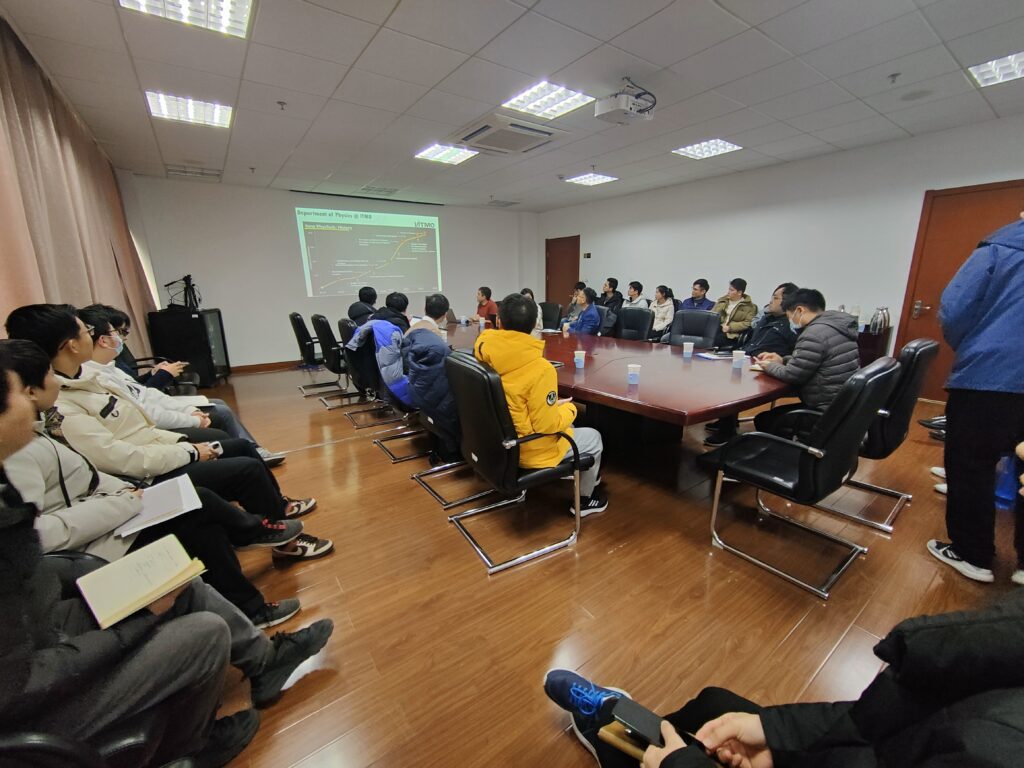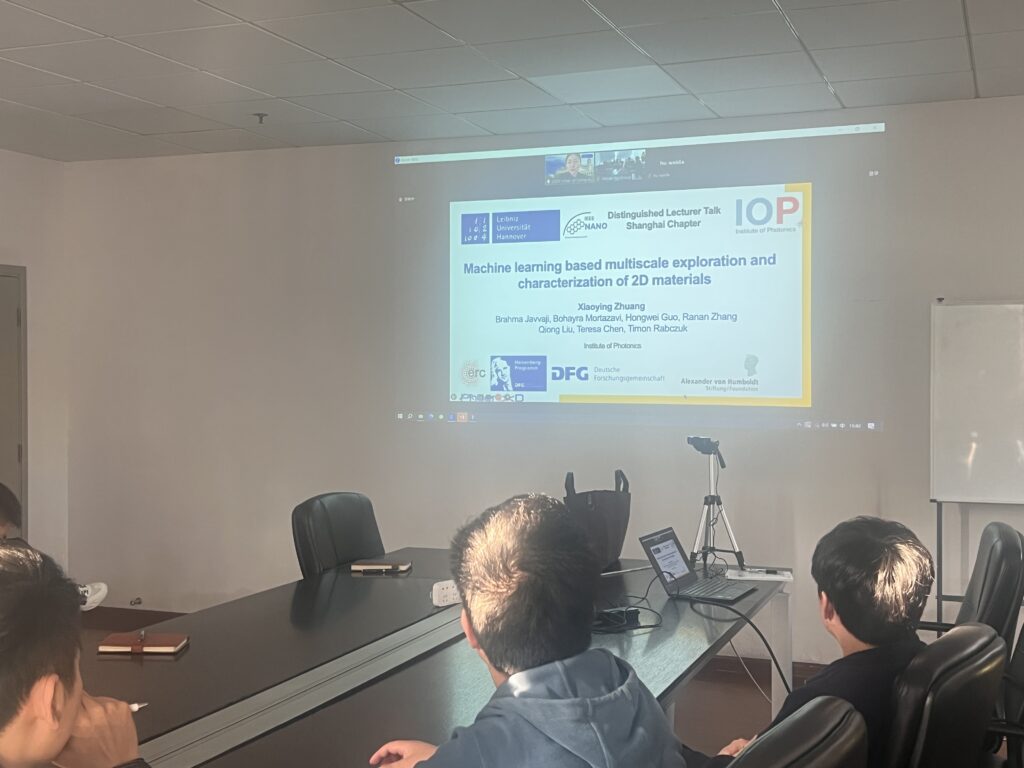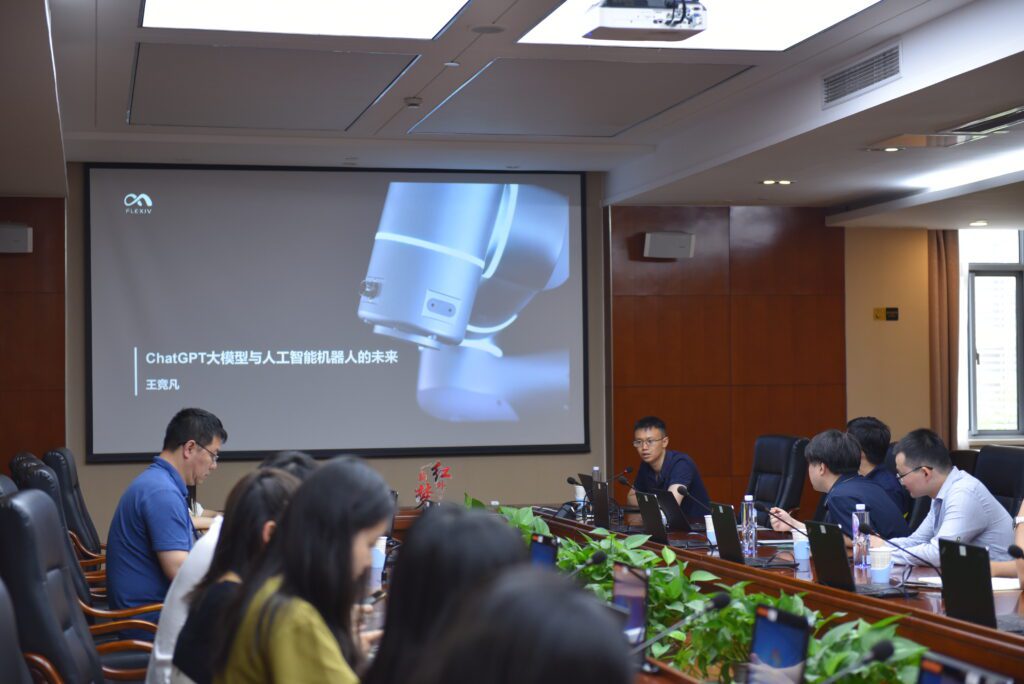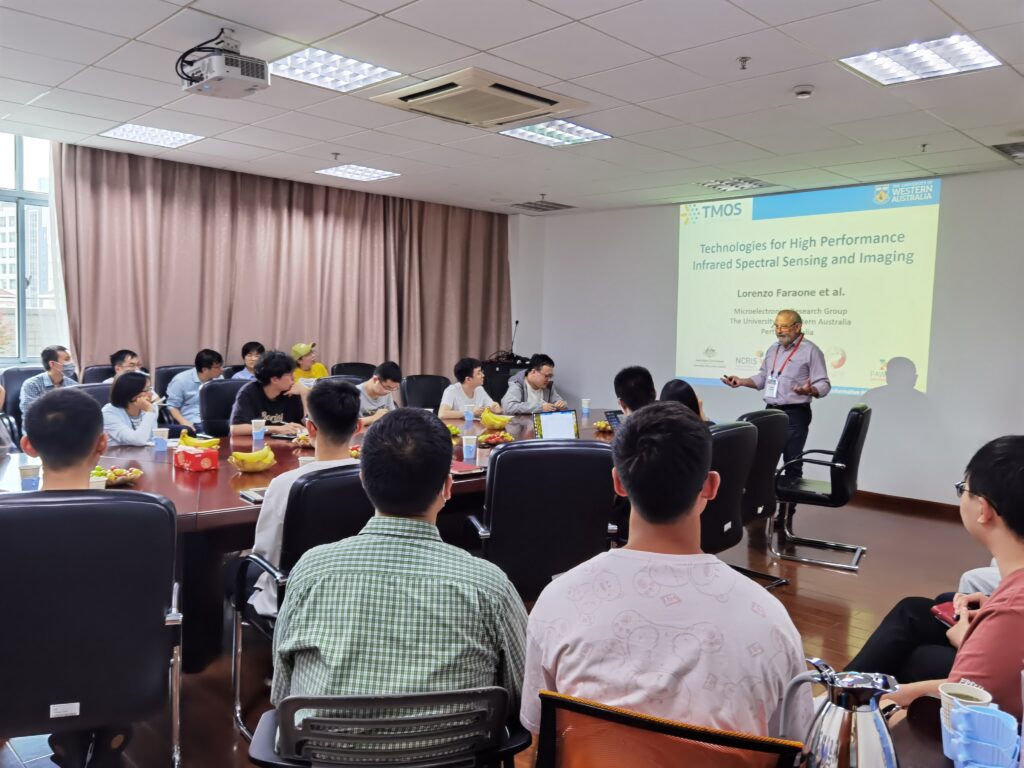
2024 New Events
From December 2023 to January 2024, Nanotechnology Distinguished Seminars (NDS) were held three times in the IEEE Nanotechnology Council (NTC) Shanghai Chapter, China. NDS Series are proposed and chaired by Prof. Weida Hu from the Shanghai Institute of Technical Physics (SITP) as the Chair of IEEE NTC Shanghai Chapter with Prof. Ivan Iorsh from lTMO University, Prof. Mario Lanza from the King Abdullah University of Science and Technology and Prof. Wenwu Pan from the University of Western Australia. There were totally 48 participants coming from China, Russia, and Saudi Arabia. NDS Series invited experts with various backgrounds to bring cutting-edge nanotechnology knowledge to our students, break down information barriers, and ultimately achieve collaborative development within the organization. A series of insightful presentations showcased groundbreaking developments in nanotechnology. Highlights of the talks included:
- Combining two-dimensional semiconductors with metasurfaces.
- Hybrid 2D/CMOS microchips.
- Dislocation Filtering Technology for defect reduction on heteroepitaxially-grown semiconductors.
Prof. Ivan Iorsh from lTMO University briefly reviewed their recent results on the light-matter coupling in 2D semiconductors integrated with photonic nanostructures. He also discussed how the realization of strong light-matter coupling might facilitate the suppression of the inhomogeneous broadening of excitons and induce a strong nonlinear optical response. Furthermore, He showed how the excitonic properties can be controlled via strong light-matter coupling and finally discussed how one can exploit strong magnetic proximity effect in order to enable magnetooptics with 2D materials. Prof. Mario Lanza from the King Abdullah University of Science and Technology discussed how to integrate 2D materials in micro/nano-electronic devices, circuits, and microchips, giving a general overview of the global progress achieved in the field and presenting our last developments in hybrid 2D/CMOS applications. He put special emphasis on devices and circuits for memristive technologies, including data storage, computation, encryption, and communication. He also discussed the main technological challenges to face in the next years and provided some recommendations on how to solve them. Prof. Wenwu Pan from the University of Western Australia showed the use of strained CdZnTe/CdTe superlattice layers as dislocation filter layers for the heteroepitaxy of II-VI CdTe buffer layers on lattice-mismatched III-V GaAs substrates. Their experimental results reviewed here suggest that the dislocation filtering technology is a promising approach for achieving high-quality heteroepitaxy of semiconductors on large-area lattice-mismatched substrates, which is crucial for the fabrication of high-performance optoelectronic devices, especially monolithically integrated devices.
The IEEE NTC Shanghai Chapter Nanotechnology Distinguished Seminar Series was a great success, making all participants rejoice in their contribution to the synergistic development within IEEE NTC Shanghai Chapter and future endeavors in the field of nanotechnology.
IEEE NTC Shanghai Chapter Nanotechnology Distinguished Seminar on Dislocation Filtering Technology
The sixth invited report of IEEE NTC Shanghai Chapter by Prof. Wenwu Pan was held on January 25, 2024. Heteroepitaxial growth of semiconductors on high-quality, large-area, commercially available substrates (e.g., Si and GaAs) is an attractive approach for achieving high-performance and cost-effective optoelectronic devices. However, obtaining a buffer layer with low defect density and a desired in-plane lattice constant for subsequent growth of device-grade epilayers remains a major challenge in heteroepitaxy. As a test vehicle, they investigated the use of strained CdZnTe/CdTe superlattice layers as dislocation filter layers for the heteroepitaxy of II-VI CdTe buffer layers on lattice-mismatched III-V GaAs substrates. Their experimental results reviewed here suggest that the dislocation filtering technology is a promising approach for achieving high-quality heteroepitaxy of semiconductors on large-area lattice-mismatched substrates, which is crucial for the fabrication of high-performance optoelectronic devices, especially monolithically integrated devices.
Currently, He is a Research Fellow in the School of Engineering at the University of Western Australia (UWA), mainly working on II-VI semiconductors. He was awarded his Ph.D. degree in Microelectronics and Solid-state Electronics at the Shanghai Institute of Microsystem and Information Technology, Chinese Academy of Sciences (SIMIT, CAS) in July 2017. Since his Ph.D. study (2012), he has been working on molecular beam epitaxial (MBE) growth and characterization of semiconductor thin film materials and their applications in optoelectronic devices such as light-emitting diodes, lasers, and detectors. He has published more than 45 peer-reviewed papers and 2 book chapter. Most of the papers have been published in well-respected journals of this field, such as Nano research, ASC photonics, Sci. Rep., Appl. Phys. Lett., J. Appl. Phys., etc.
IEEE NTC Shanghai Chapter Nanotechnology Distinguished Seminar on Hybrid 2D/CMOS Microchips
The fifth invited report of IEEE NTC Shanghai Chapter by Prof. Mario Lanza was held on January 5, 2024. In this talk, Prof. Mario Lanza discussed how to integrate 2D materials in micro/nano-electronic devices, circuits, and microchips, giving a general overview of the global progress achieved in the field and presenting our last developments in hybrid 2D/CMOS applications. He put special emphasis on devices and circuits for memristive technologies, including data storage, computation, encryption, and communication. He also discussed the main technological challenges to face in the next years and provided some recommendations on how to solve them.
Mario Lanza got the PhD in Electronic Engineering (with honors) in 2010 at the Autonomous University of Barcelona. In 2010-2011 he was NSFC postdoctoral fellow at Peking University, and in 2012-2013 he was Marie Curie postdoctoral fellow at Stanford University. In October 2013 he joined Soochow University as Associate Professor, and in March 2017 he was promoted to Full Professor. Since October 2020 he has been an Associate Professor of Materials Science and Engineering at the King Abdullah University of Science and Technology (KAUST, in Saudi Arabia), where he leads a group formed by 10 PhD students and postdocs. His research focuses on how to improve electronic devices and circuits using 2D materials, with special emphasis on resistive switching applications. Prof. Lanza has published over 185 research articles, including 1 Nature, 2 Science, 6 Nature Electronics and multiple IEDM proceedings (among others), and has registered four patents – one of them granted with 1 million USD. Prof. Lanza has received multiple top distinctions, like the IEEE Fellow, Young 1000 Talent, Marie Curie (among others), and he is a Distinguished Lecturer from the IEEE – Electron Devices Society. Prof. Lanza is the Editor-in-Chief of the journal Microelectronic Engineering (Elsevier), and he serves in the board of many other journals and international conferences, including IEEE-IEDM and IEEE-IRPS.
2023 New Events
IEEE NTC Shanghai Chapter Nanotechnology Distinguished Seminar on Combining Two-dimensional Semiconductors with Metasurfaces
The fourth invited report of IEEE NTC Shanghai Chapter by Prof. Ivan Iorsh was held on December 21, 2023. In the talk, Prof. Ivan Iorsh briefly reviewed their recent results on the light-matter coupling in 2D semiconductors integrated with photonic nanostructures. He also discussed how the realization of strong light-matter coupling might facilitate the suppression of the inhomogeneous broadening of excitons and induce a strong nonlinear optical response. Furthermore, He showed how the excitonic properties can be controlled via strong light-matter coupling and finally discussed how one can exploit strong magnetic proximity effect in order to enable magnetooptics with 2D materials.
Pro. Ivan Iorsh obtained his PhD in 2013 in Durham University. Since 2016 he has been a Professor in lTMO University, Russia. He is the Reviewer of Nature Communications, Physical Review Letters, 2D Materials, New Journal of Physics, Physical Review A, B. His main areas of interest include exciton-polaritons, waveguide and cavity quantum electrodynamics, and light-matter coupling in low-dimensional materials.
IEEE NTC Shanghai Chapter Nanotechnology Distinguished Seminar on Machine Learning
On November 24th, the third invited report of IEEE NTC Shanghai Chapter by Prof. Xiaoying Zhuang was successfully conducted in Shanghai Institute of Technical Physics(SITP), Chinese Academy of Science(CAS). Prof. Xiaoying Zhuang, from Leibniz University Hannover, who served as Chair of Computational Science and Simulation Technology, presented a report focusing on machine learning based multiscale exploration and characterization of 2D materials. The team of Prof. Xiaoying Zhuang developed machine-learning interatomic potentials(MLIPs) passively fitted to computationally inexpensive ab-initio datasets which can be to evaluate the complex physical properties of nanostructured materials, with only a fractional computational cost of conventional DFT-based solutions, cutting down from months to tens of hours. MLIPs offer extraordinary capabilities to marry the first-principles accuracy with multiscale modeling and thus enable the modeling of complex nanostructures at continuum level and has flexibility without paying unaffordable computational costs. Their works show outstanding and robust potential to develop fully automated platforms, to design, optimize, and explore various properties of 2D materials and structures at continuum level, and with inherent precision and robustness. The presentation was successful and many other experts including Prof. Weida Hu (Chair of IEEE NTC Shanghai Chapter), Dr. Fang Wang, Dr. Tiange Zhao, and Dr. Kun Zhang all joined in and had a heated discussion on the topic.
IEEE-NANO 2023
The 23rd IEEE International Conference on Nanotechnology (IEEE-NANO 2023) was successfully held from July 2-5, 2023 at Jeju Island, Korea. The conference focused on the promotion of advanced research in the fields of nanoscience and nanotechnology. Prof. Weida Hu (Chair of Shanghai NTC Chapter) from Shanghai Institute of Technical Physics, Chinese Academy of Sciences was invited as the keynote speaker at the conference to present a report about Nanoscale Photodetectors for Infrared Sensing and Intelligent Recognition. In addition, the Special Invited Session 18 (SIS18) co-organized by Weida Hu and Jinshui Miao focued on nanoscale photodetectors and intelligent perceptions and was innovative. The SIS18 has achieved a great success and showed many excellent reports from Prof. Sanhong Bei, Prof. Deep Jariwala, Prof. Lan Fu, Prof Jinshui Miao, Dr. Zhen Wang, Dr. Runzhang Xie and so on.
IEEE NANO Shanghai Chapter Nanotechnology Distinguished Seminar
On June 16th, the first invited report of IEEE NTC Shanghai Chapter Nanotechnology Distinguished Seminar by Dr, Wang Jingfan was successfully conducted in Shanghai Institute of Technical Physics(SITP), Chinese Academy of Science(CAS). Dr. Wang Jingfan, served as an industry supervisor of professional gradudate degree of Zhejiang University and an off-campus supervisor of Chinese University of HongKong (Shenzhen), presented a report focus on large models ChatGPT and the future of AI robots. He introduced different application exploration of AI fusion humanoid robot technology in multiple scenarios and possible development of artificial intelligence. Other exports including Weida Hu(Chairman of IEEE NTC Shanghai Chapter), Yuzhi Shi, Yi Zhou,GangChen, Yueming Wang and Fanshen Chen from IEEE Nano Shanghai Chapter, Tongji University and SITP all joined hot discussion of topics.
IEEE NTC Shanghai Chapter Infrared Technology Distinguished Seminar
On September 25th, the second invited report of IEEE NTC Shanghai Chapter by Prof. Lorenzo Faraone was successfully conducted in Shanghai Institute of Technical Physics(SITP), Chinese Academy of Science(CAS). Prof. Lorenzo Faraone, from University of Western Australia, served as a member of the Order of Australia, and a fellow of the IEEE, the Australian Academy of Science and the Australian Academy of Technological Sciences Engineering, presented a report focusing on well-established HgCdTe-based technologies. Besides, the presentation also described MEMS-based tuneable filter technologies suitable for on-chip integration that can provide a low size, weight and power solution for multi-spectral sensing and imaging. The presentation was successful and many other experts including Prof. Weida Hu (Chair of IEEE NTC Shanghai Chapter), Dr. Fang Wang, Dr. Zhen Wang and Dr. Haonan Ge all joined in and had a heated discussion on the topic.


































